Showfoto/Curves Adjust/tr: Difference between revisions
Created page with "Bu neden oluyor? Çünkü fotoğraf ''çok yüksek bir dinamik erime'' sahip, yani çok koyudan (arkaplan) çok parlağa (flaş ile aydınlanmış olanlar) nesneler içeriyor." |
Created page with "Bu tarz görüntülerde düzeyler aracının girdi ayarlarıyla oynadığımızda resmin grilik seviyesi bilgisinin bir kısmını siler, dolayısıyla bazı detayları kaybeder ..." |
||
| Line 20: | Line 20: | ||
Bu neden oluyor? Çünkü fotoğraf ''çok yüksek bir dinamik erime'' sahip, yani çok koyudan (arkaplan) çok parlağa (flaş ile aydınlanmış olanlar) nesneler içeriyor. | Bu neden oluyor? Çünkü fotoğraf ''çok yüksek bir dinamik erime'' sahip, yani çok koyudan (arkaplan) çok parlağa (flaş ile aydınlanmış olanlar) nesneler içeriyor. | ||
Bu tarz görüntülerde düzeyler aracının girdi ayarlarıyla oynadığımızda resmin grilik seviyesi bilgisinin bir kısmını siler, dolayısıyla bazı detayları kaybeder ve iyi bir sonuç elde edemeyiz. | |||
So what to do now? We can use the <menuchoice>Curves Tool</menuchoice> from the menu <menuchoice>Colors -> Curves Adjust...</menuchoice>: [[Image:Adjustcurves.png|20px]] | So what to do now? We can use the <menuchoice>Curves Tool</menuchoice> from the menu <menuchoice>Colors -> Curves Adjust...</menuchoice>: [[Image:Adjustcurves.png|20px]] | ||
Revision as of 17:28, 31 December 2010
KDE Fotoğraf Rehberi 1-2 - Eğrilerin Ayarlanması
Unai Garro (uga) - 2008 Yazı
Bu, KDE'nin fotoğrafçılık araçlarının (yani ShowFoto ve/veya Krita'nın) fotoğrafları işlemek, düzenlemek ve düzeltmek için nasıl kullanılacağını anlatmayı amaçlayan rehberlerin ikinci kısmı. Rehberlerin ilk kısmı histogramların nasıl yorumlanması gerektiğini, düzeyler aracının nasıl kullanacağını göstermişti. Bu rehber daha gelişmiş bir aracın, Eğrilerin Ayarlanması aracının nasıl kullanıldığını gösterecek. Bu araç düzeyler aracından çok daha güçlü, ancak iyi sonuçlar almak sabır ve deneyim gerektiriyor.
Haydi başlayalım. Bu sefer aşağıda gördüğünüz Jos van den Oever'in Akademy 2008 fotoğraflarından bağışlanmış fotoğrafı düzelteceğiz.
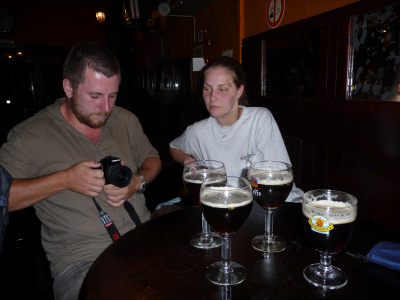
Bu resimdeki problem de bazı kısımlarının çok karanlık olması. Resimdeki iki kişi açıkça görülüyor, oysa arka plan o kadar karanlık ki barın detaylarını göremiyoruz. Bakalım ilk derste öğrendiğimiz gibi düzeyler aracını kullandığımızda ne oluyor:
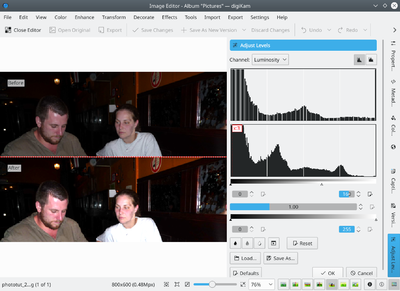
Görebileceğiniz üzere düzeyler aracını kullanırsak görüntünün bazı kısımları beyazlaşıyor. Bu ne anlama geliyor? Bu resmin histogramın sağ kısmında bulunan ve beyaza dönüştürülen kısımları olduğu anlamına geliyor. Bunun sebebi bu görüntünün histogramının bir önceki rehberdekinin aksine sol tarafta toplanmamış olması. Görüntü tüm histogramı kapsıyor ve biz histogramı girdi ayarlarında keserken görüntü ile ilgili bilginin bir kısmını yemiş oluyoruz.
Bu neden oluyor? Çünkü fotoğraf çok yüksek bir dinamik erime sahip, yani çok koyudan (arkaplan) çok parlağa (flaş ile aydınlanmış olanlar) nesneler içeriyor.
Bu tarz görüntülerde düzeyler aracının girdi ayarlarıyla oynadığımızda resmin grilik seviyesi bilgisinin bir kısmını siler, dolayısıyla bazı detayları kaybeder ve iyi bir sonuç elde edemeyiz.
So what to do now? We can use the from the menu : ![]()
Selecting this option will show a new popup with a dialog that may look similar to the levels tool. You can see the resulting histogram on top, and the input histogram on the bottom, just like in the levels tool:
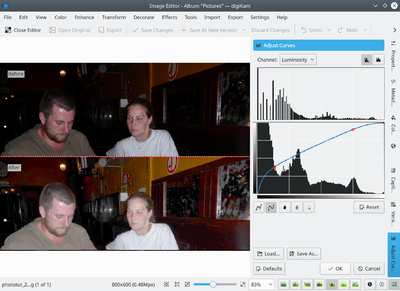
The difference is in the way the control works. In this tool, the input histogram has a diagonal line in it. Clicking on it with the left button of the mouse, adds control points. You can move those control points up or down. The result, as shown in the picture above, is that the gray levels from the horizontal axis are converted into the gray levels in the vertical axis.
Moving the control points up, makes that part of the image brighter. Moving them down, makes that part of the image darker.
In this case, I wanted to make the darkest parts of the image brighter, so I added a control point on the left part of the histogram, and moved the point upwards. As the rest of the image was also getting a bit too bright, I added a second control point to avoid it.
So, lets press and see what we get of it:
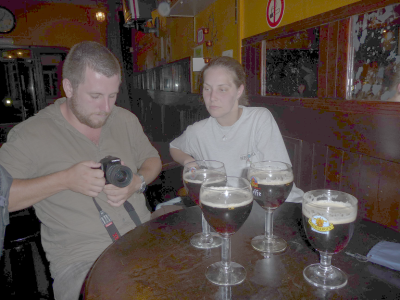
We have managed to make the shadows brighter, and now the pub is more visible, but the image is now a bit washed out. As if it were too bright all over the place. Can we do something? Sure, lets try the levels adjustment again:
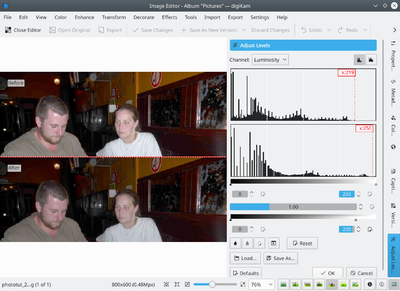
Now that the shadows were adjusted using the curves, and the colors are more uniform, we can follow the method shown in the first tutorial and adjust the levels of the photo, as shown above. The histogram's main data was a bit displaced to the left, and adjusting levels, I made it cover the whole range again.
Lets see the result - Ah, now this is much better. The pub background is much more visible and the two persons are not blown:
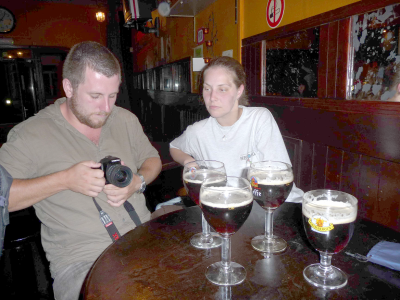
I think that's already acceptable, but if we are picky, the two people are a bit washed out due to the flash light. So, even if that goes out of the scope of this tutorial (it'll be covered in the following tutorials), lets adjust a bit the saturation and contrast in the image for a better result:
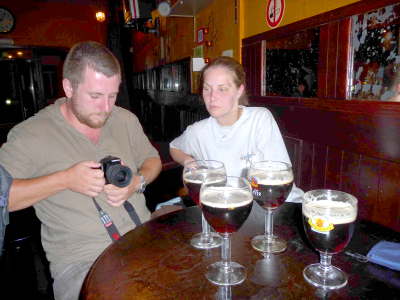
Now this image looks much nicer than the original, yes. I hope you liked this tutorial and will see you in the next one!

